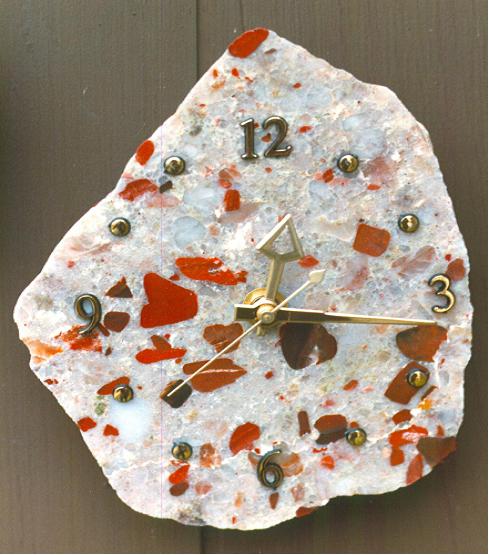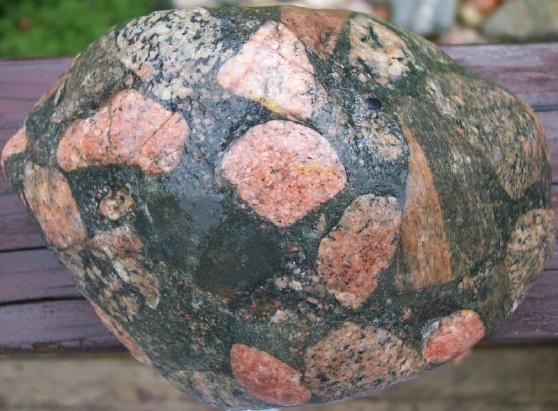CONGLOMERATE
( Fr- conglomérat; Ger-
Konglomerat; Nor- konglomerat;
Rus-  )
)
CONGLOMERATE

A. Conglomerate, "jasper puddingstone"
clock (greatest dimension - ca.
25 cm) fashioned from a boulder of
the Lorrain Conglomerate that was collected from reworked glacial drift
off Richards
Landing, St. Joseph Island (in northern Lake Huron), Ontario, Canada.
H.W. Courtney
collection. (© photo by H.W. Courtney)
DESCRIPTION: Conglomerate is a sack name
for rocks that consist of rounded to subrounded fragments (pebbles,
cobbles and boulders, which are usually referred to as clasts) surrounded by a finer
grained matrix (e.g.,
sandstone) -- i.e., conglomerates are lithified gravels.
(It
seems prudent also to note here that some so-called conglomerates
include as many or even more angular than round clasts and should be
called breccia-conglomerates, conglomerate-breccias or even
breccia.) In any case, both
the clasts and matrices of many conglomerates consist of relatively
resistant
rocks and/or minerals such as quartzite and quartz.
The compositions, color(s),
effective hardness, specific gravity, breakage and other properties of
diverse conglomerates differ within
a rather large range. Therefore, they are not listed here. This
does seem to be a good place to note that so
far as any use they have had or might have in the future, only
conglomerates with pebble size clasts seem to fit that role. But,
conglomerates with larger clasts have found
use as, for example, ashlar and hewn building stone.
OTHER NAMES: Several conglomerates have
been given formal stratigraphic names (see Appendix B, Glossary). Three
examples are the Fincastle Conglomerate of central western
Virginia, the Kanayut Conglomerate in the Brooks Range of Alaska
and
the well known Shinarump Conglomerate of Arizona. The following
are examples of other names given conglomerates, most of which have
been used as gemrocks:
- Cherry cake conglomerate - a conglomerate,
formally designated the Andre Point Grit, that crops out on, for
example, Andre Point on the western end of Toco Bay, near the
northeastern tip of Trinidad. The conglomerate -- a photograph of
which is on the web site www.gstt.org -- is described as consisting of
red ferruginous claystone pebbles (and a few white vein-quartz
pebbles) within a "coarse, gritty, [off-white] quartzose matrix."
(ibid.)
- Kingstonite - name given to a conglomerate
with its matrix and even some of its clasts, nearly all of which are
pebble-size, replaced by native copper. This rock, which comprises
parts
of some of the ore bodies of the famous Copper District of Michigan's
Keweenaw
Peninsula, has been fashioned by lapidaries into such things as
bookends (see Rosemeyer, 2001, Figure 32).
- ... puddingstone - one British and three American gemrocks frequently, though not
formally designated puddingstones, follow:
a)
Hertfordshire puddingstone,
named for its occurrences north in Hertfordshire (north of London) and
nearby areas consists of flint pebbles within a light-brown
(ginger-) colored quartz sandstone.
b)Jasper
puddingstone,
formally named the Lorrain
Conglomerate (see Figure A), crops out here and there in a belt that
extends from west and north of Sault Ste Marie eastward beyond Bruce
Mines, Ontario -- e.g.,
near the
north end of St. Joseph Island
(in Lake Huron), Ontario -- and occurs as pebbles, cobbles and
boulders here and there in
Pleistocene glacial deposits in Ontario, Michigan, Ohio, Indiana,
Illinois and eastern Iowa.
c) Roxbury puddingstone, also
known as the Roxbury Conglomerate, from small quarries within Roxbury,
which is now a part of Boston, Massachusetts is the official "rock or
rock emblem" of the commonwealth of Massachusetts.
d) Fairburn Conglomerate
(name pending), which consists of red, yellow, tan, orange and
lavender jasper pebbles surrounded by a quartzite matrix occurs near
Fairburn, South Dakota (Mitchell, 1985).
- Puddingstone jade, which has
found some use as a gemrock, may or may not belong in this entry;
I have not seen a specimen, a good photograph or
a good description of this material; as
noted in the NEPHRITE entry, it is said to consist of
nodular-shaped masses of relatively light green nephrite
within a darker green matrix, but what "nodular-shaped masses" and
"matrix" mean is beyond my ken.
- Tillite conglomerate (breccia,
conglomerate-breccia or conglomeratic tillite, etc.) -- rocks formed by
lithification of glacial tills. See Figure B.

USES: Pendants, bookends, clocks and
diverse ornaments; also as a facing stone -- e.g., glacially transported and
deposited boulders of Lorrain Conglomerate are used in masonry,
as landscape accents, and even as monuments (boulders, as found;
mosaics made of small boulders and/or sawed and polished sections of
those boulders; and also large boulders, as such or sawed and polished
like medium sized tombstones). Also, though larger
than the delimiting breadbox mentioned in the introduction, Welsh conglomerate fruitmills (see www.walcot.com).and
conglomerate millstones from several localities -- e.g., the Cloyd Conglomerate from
Brush Mountain, Giles County, Virginia
-- seem noteworthy here; among other things, several of
these "stones" have found use as, for example, landscape accents.
OCCURRENCES: Conglomerates occur within sequences of detrital
sedimentary rocks, and metaconglomerates, many of which are virtually
indistinguishable from sedimentary conglomerates, occur in the
metamorphosed sedimentary sequences. And, both rocks are
relatively common in
unconsolidated
deposits -- e.g., glacial debris and beach gravels -- derived
from
those strata; this is true because most conglomerates and
metaconglomerates
are relatively resistant to both chemical and physical weathering and
erosion.
NOTEWORTHY LOCALITIES: See localities
noted under
OTHER NAMES subheading.
REMARKS: The designation conglomerate
comes from the Latin con- glomerāre
meaning to wind into a ball, apparently in allusion to these rocks'
consisting of so-to-speak clustered masses of clasts and their surrounding matrix materials. This origin is intriguing
in that I, and I suspect many petrologists, immediately thought
of armored mud balls when we first saw this etymology given for
conglomerate. Also, from the nomenclature standpoint, as already
noted, the designation metaconglomerate is usually applied to metamorphosed conglomerates.
The term puddingstone,
frequently
applied to conglomerates in Great Britain, is
usually applied
only in vernacular elsewhere. To me, puddingstone is best given
only certain conglomerate (if any). The conglomerates -- at least
the ones I have seen -- that may warrant the name puddingstones differ
from so-to-speak normal conglomerates in two
ways: they have fewer pebbles per unit volume
of the total rock,
and the color(s) of their
pebbles differ markedly
from the color of the surrounding matrix. This usage would, it
seems, be possibly useful and also in harmony with the origin of the
term, which is said to have arisen because these rocks "look like plum
pudding."
So far as gemrocks are concerned, the Lorrain
Conglomerate, often referred to as Jasper puddingstone, is an
especially good
example of the just mentioned appearance. -- Most of its pebble-size
fragments are red jasper whereas the
matrix, which makes up the predominant part of the rock, is white or
off-white
quartzite. (It is of at least passing interest that this rock has
been given several names by those who are familiar with it because of
appearance and its rather widespread occurrence in glacial deposits in
the upper midwestern United States. Of the several interesting
ones I heard while plotting its distribution as boulders, cobbles and pebbles in glacial deposits (during the 1970s) the name
that seemed to me to be the farthest
out was "lipstick
rock" -- apparently based on the red color of its jasper pebbles.
(Perhaps a collection of these vernacular appellations should be
recorded, eh?!)
Polymict (=polymictic) conglomerates -- i.e., conglomerates with pebbles (etc.) of several different rocks --
are of particular interest to the geologist as well as to lapidaries
and others who fashion things from them. For geologists,
congomerates frquently hold the many clues that may help them decipher
the geological history of the region where they occur. For those
who fashion things from them, many of these rocks have a strong
positive aspect but also a noteworthy negative characteristic: On
the positive side, many of these conglomerates are extremely attractive
and each one -- indeed each
piece -- is unique; these are great selling points for their
products. On the negative side, each of the different rock types
of the pebbles (etc.) may require somewhat
different treatment so far as having an end product with surface(s)
that appear equally polished (or whatever); but fortunately some
polymict conglomerates do not pose such difficulties, and those
that do provide the challenges that some lapidaries and
carvers seem to thrive on.
I could not resist including the following from a web site to
which my attention was directed. Entitled "Edible conglomerates,"
it is attributed to Luann Byerly as part of a Teacher's guide for
a grades 4-9 science project in Iowa: "Conglomerates contain
pebbles of different types of rocks in a variety of shapes and sizes.
Popcorn balls can resemble real conglomerates by adding colored
marshmallows, candy (like M&M's) and nuts. In addition,
conglomerates are formed under pressure and cemented together by
precipitated chemicals: similarly, popcorn balls are cemented together
by the students' hands and a syrup
mixture."(www.aea10.k12.ia.us/curr/science/sci4-9/RockMin/Rockm471)
What an experience!!!
As already noted, the Roxbury puddingstone is the state rock of
Massachusetts.
SIMULANT:
***Concrete with gravel aggregate - [An often
suggested criterion is that matrices of concretes effervesce with
dilute HCl whereas those of conglomerates do not. Although this
is a fairly good criterion so far as distinguishing between most of
these two materials, it is not
absolute: Some
conglomerates have matrices that effervesce with HCl. In my
opinion, the best check, using only macroscopic examination, is to look
for sporadic small holes, which represent entrapped air bubbles;
they are
relatively common around the pebbles of concretes
whereas they occur only rarely, if ever, around pebbles of
conglomerates.].
REFERENCES: No general
reference. Dake, Fleecer & Wilson, 1938; Frondel, 1962
| Top | Home |
R. V. Dietrich © 2015
Last
update: 3 June 2008
web page created by Emmett Mason
![]() )
)
